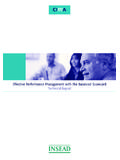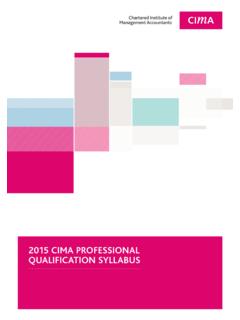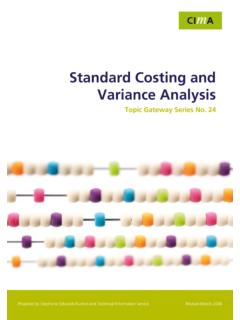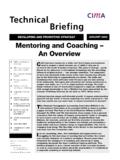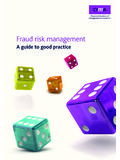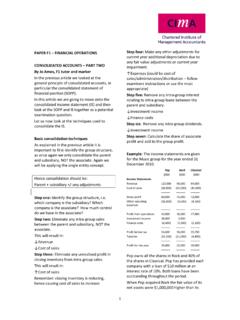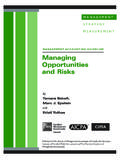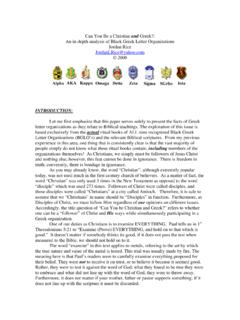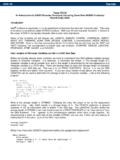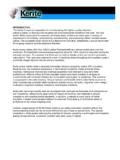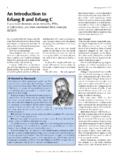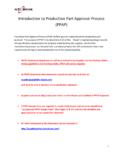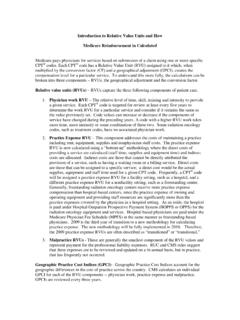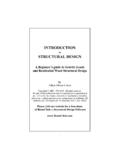Transcription of Introduction to Risk Management - CIMA
1 Introduction to managing risk Topic Gateway Series 1 Prepared by Jasmin Harvey and Technical Information Service Last reviewed February 2008 Introduction to managing risk Topic Gateway series no. 28 Introduction to managing risk Topic Gateway Series About Topic Gateways Topic Gateways are intended as a refresher or Introduction to topics of interest to CIMA members. They include a basic definition, a brief overview and a fuller explanation of practical application. Finally they signpost some further resources for detailed understanding and research. Topic Gateways are available electronically to CIMA members only in the CPD Centre on the CIMA website, along with a number of electronic resources.
2 About the Technical Information Service CIMA supports its members and students with its Technical Information Service (TIS) for their work and CPD needs. Our information specialists and accounting specialists work closely together to identify or create authoritative resources to help members resolve their work related information needs. Additionally, our accounting specialists can help CIMA members and students with the interpretation of guidance on financial reporting, financial Management and performance Management , as defined in the CIMA Official Terminology 2005 edition. CIMA members and students should sign into My CIMA to access these services and resources.
3 The Chartered Institute of Management Accountants 26 Chapter Street London SW1P 4NP United Kingdom T. +44 (0)20 8849 2259 F. +44 (0)20 8849 2468 E. 2 Introduction to managing risk Topic Gateway Series 3 Introduction to managing risk Definition and concept What is risk? Risk is a condition in which there exists a quantifiable dispersion in the possible outcomes from any activity. It can be classified in a number of ways. CIMA Official Terminology, 2005 Risk has also been defined as: Uncertain future events which could influence the achievement of the organisation s strategic, operational and financial objectives.
4 International Federation of Accountants,1999 Risk Management is: A process of understanding and managing the risks that the entity is inevitably subject to in attempting to achieve its corporate objectives. For Management purposes, risks are usually divided into categories such as operational, financial, legal compliance, information and personnel. One example of an integrated solution to risk Management is enterprise risk Management . CIMA Official Terminology,2005 Context Risk Management is core to the current syllabus for P3 Management accounting risk and control strategy of the professional qualification. Students must understand risk Management and may be examined on it.
5 In the CIMA Professional Development Framework, risk features in a number of areas including governance, enterprise risk Management , strategic Management , strategic risk and business skills, business acumen, manage risk. Related concepts Risk Management ; enterprise risk Management Introduction to managing risk Topic Gateway Series 4 Overview Risk is of paramount importance to organisations. Businesses must identify, evaluate, manage and report many types of risk for improved external decision making. Risk can be classified in a number of ways. Here it is classified according to the CIMA Official Terminology. Business or operational: relating to activities carried out within an entity, arising from structure, systems, people, products or processes.
6 Country: associated with undertaking transactions with, or holding assets in, a particular country. Risk might be political, economic or stem from regulatory instability. The latter might be caused by overseas taxation, repatriation of profits, nationalisation or currency instability. Environmental: these risks may occur due to political, economic, socio-cultural, technological, environmental and legal changes. Financial: relating to the financial operations of an entity and includes: credit risk: a loss may occur from the failure of another party to perform according to the terms of a contract currency risk: the value of a financial instrument could fluctuate due to changes in foreign exchange rates (IAS 32) interest rate risk: interest rate changes could affect the financial well being of an entity liquidity (or funding) risk: an entity may encounter difficulty in realising assets or otherwise raising funds to meet financial commitments.
7 Reputational: this is damage to an entity's reputation as a result of failure to manage other risks . Strategic risk: these are risks stemming from the entity's strategy and pose the greatest threat to the achievement of the strategy. Introduction to managing risk Topic Gateway Series 5 Risk can be perceived in a number of ways. Collier and Agyei-Ampomah (2006) note the following. Risk as a hazard or threat (downside risk): this is what managers often mean when talking about risk. It is referred to as a negative event or threat to the organisation. Managing risk in this context means using Management techniques to reduce the probability or impact of the negative event without undue cost.
8 Risk as uncertainty: this is reflected in the CIMA Official Terminology definition where risk is the distribution of all possible outcomes, both positive and negative. Managing risk in this context means reducing the variance between anticipated and actual outcomes. Risk as opportunity (upside risk): risk can be seen as a source of opportunity to business. Risk Management in practice risks are not always seen in the same way. Collier and Agyei-Ampomah (2006) explain that risk appetite and risk culture are important in understanding the nature of risk Management . Risk appetite This is the amount of risk an organisation is willing to accept in pursuit of value. It is directly related to an organisation's strategy and may be expressed as the acceptable balance between growth, risk and return.
9 Risk culture This is the set of shared attitudes, values and practices that characterise how an entity considers risk in its daily activities. Risk culture is mainly derived from an analysis of organisational practices, namely rewards or sanctions for risk-taking or risk-avoiding behaviour. Introduction to managing risk Topic Gateway Series 6 Approaches to managing risk Many approaches exist to managing risk. These include but are not limited to: the Committee of Sponsoring Organisation s (COSO) ERM Framework HM Treasury s Orange Book CIMA's risk Management cycle the AIRMIC, ALARM, IRM Risk Management standard standards Australia AS/NZS Standard on Risk Management .
10 This topic gateway takes a generic approach that does not rely on any particular model. Managing risk involves risk assessment, risk Management policy, risk response (also known as risk treatment), risk reporting and residual risk reporting. Managing risk a generic approach 1. Risk assessment This comprises the analysis and evaluation of risk through processes of identification, description and estimation. Identification: this aims to determine an organisation's exposure to uncertainty. It requires a thorough knowledge of the organisation's strategy, its products/services and markets, and the legal, social, political, economic and technological environment in which it exists.

